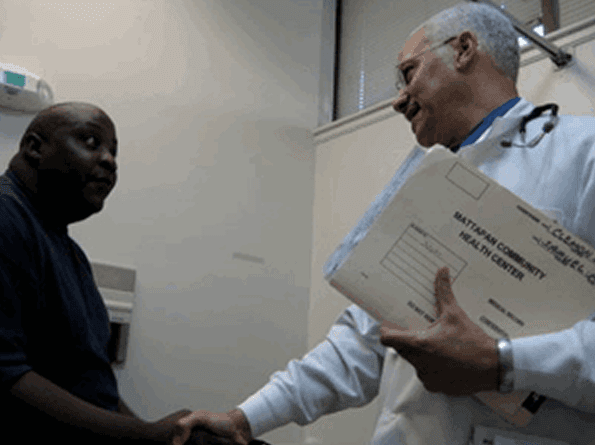Color of you skin makes a difference in how much Vitamin D you get
Samuel Clemens talks with his doctor, Douglass Bibuld, about vitamin D at a recent check up at Mattapan Community Health Center in Boston. (Photo by Ashley Ahearn.)
There are a few things you should know about Vitamin D.
First, it’s not a vitamin. In the body it acts like a hormone, and it plays a critical role in making bones strong, beefing up the immune system and regulating the growth of cells.
Not having enough Vitamin D may increase your chances of getting certain cancers, osteoporosis, diabetes – even Parkinson’s Disease — and the Centers for Disease Control says 70 percent of us don’t get enough of it.
Sure, you can get Vitamin D for milk, and your doctor may prescribe pills for it as well, but the simplest way to get Vitamin D is from the sun.
But there’s a catch. The darker your skin, the harder it is for your body to make Vitamin D — which means black Americans are twice as likely to have an insufficient amount of Vitamin D.
Samuel Clemens recently went for a routine check-up at the Mattapan Community Health Center in Boston.
Dr. Douglass Bibuld told him his Vitamin D levels were unacceptably low.
“Below 30 is considered insufficient, below 20 is considered deficient and Mr. Clemens was at eight,” he said.
That’s eight nanograms per milliliter of blood. Bibuld wanted to get Clemens’ level up to 40, so he put him on 7,000 units of Vitamin D per day. That’s 17 times more than the government recommends for adults.
Clemens is hardly the only patient at Mattapan, which sees a mostly black American clientele, who has Vitamin D levels way below what is considered healthy — some 90 percent of its patients, in fact.
“The supplement is taking the place of the sun,” Bibuld told Clemens. “If we lived in a place where there was stronger sun, then you would be able to make it in your skin, but since we live in an area where the sun is so weak because you have melanin in your skin, which is a potent sun blocker, we need to replace it with a supplement.”
It’s thought that people whose ancestry traces back to equatorial regions — where the sun’s UV rays are the strongest — developed more melanin in their skin for protection.
Dr. Michael Holick, an expert on Vitamin D at the Boston University School of Medicine, says in places where the sun’s rays are weaker, people with more melanin are at a disadvantage.
“It’s like wearing a sunscreen with a sun protection factor of 15 which reduces your ability to make Vitamin D in your skin by 99 percent, and that’s why most African Americans are at extremely high risk of Vitamin D deficiency,” he explained.
Holick believes Vitamin D deficiency may be associated with the higher rate of cancer among African Americans.
If a cell turns cancerous, Vitamin D delivers the instructions for that cell to self-destruct. Not enough Vitamin D and that cancer cell might keep reproducing.
The science of Vitamin D is only now beginning to be understood — and the research is sparking some controversy.
Many doctors say light-skinned people need 15 minutes of sun each day to get enough Vitamin D, but dermatologists are concerned exposure to sunlight may lead to skin cancer. And Holick has come under fire for getting five percent of his research funding from a group that represents the indoor tanning industry.
There’s not a clear consensus on a recommended dose of Vitamin D either. Some experts say that adults of all skin colors should take 1,000 units of Vitamin D per day and that some individuals may need more. But the government recommends much less; 200 units of Vitamin D per day for newborns to teenagers, 400 for adults, and 600 for people over 70.
“We don’t have a good history of people taking high doses for long periods of time, so I am very fearful of toxicity with all this enthusiasm, quite frankly,” said Dr. Mary Frances Picciano, a senior research scientist in the Office of Dietary Supplements at the National Institutes of Health.
Dr. Azzie Young, the president of Mattapan Community Health Center, says his clinic sees some of the most serious health problems in Boston.
“Once we learned that Vitamin D deficiency is a major disease for our community we were very concerned about getting everybody on board, making sure that all of our patients have a sufficient level of Vitamin D,” he said.
But it’s not just the patients that are concerned about Vitamin D. As an African American, it’s on Young’s mind as well.
“I had a dismal 12 — yeah, my level was 12 nanograms per milliliter,” he said.
Young takes 3,000 units of Vitamin D per day. That’s about three times what most Vitamin D experts recommend but her levels were so low, that’s what it took to bring them up.
“It has made a big difference in my life and I’ve been spreading the word in any kind of way we can,” she said. “I feel wonderful. I can bounce out of a chair. I can walk without any problems and also I sleep better.”
